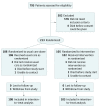Effect of a Lay Health Worker Intervention on Goals-of-Care Documentation and on Health Care Use, Costs, and Satisfaction Among Patients With Cancer: A Randomized Clinical Trial
- PMID: 30054634
- PMCID: PMC6233780
- DOI: 10.1001/jamaoncol.2018.2446
Effect of a Lay Health Worker Intervention on Goals-of-Care Documentation and on Health Care Use, Costs, and Satisfaction Among Patients With Cancer: A Randomized Clinical Trial
Abstract
Importance: Although lay health workers (LHWs) improve cancer screening and treatment adherence, evidence on whether they can enhance other aspects of care is limited.
Objective: To determine whether an LHW program can increase documentation of patients' care preferences after cancer diagnosis.
Design, setting, and participants: Randomized clinical trial conducted from August 13, 2013, through February 2, 2015, among 213 patients with stage 3 or 4 or recurrent cancer at the Veterans Affairs Palo Alto Health Care System. Data analysis was by intention to treat and performed from January 15 to August 18, 2017.
Interventions: Six-month program with an LHW trained to assist patients with establishing end-of-life care preferences vs usual care.
Main outcomes and measures: The primary outcome was documentation of goals of care. Secondary outcomes were patient satisfaction on the Consumer Assessment of Health Care Providers and Systems "satisfaction with provider" item (on a scale of 0 [worst] to 10 [best possible]), health care use, and costs.
Results: Among the 213 participants randomized and included in the intention-to-treat analysis, the mean (SD) age was 69.3 (9.1) years, 211 (99.1%) were male, and 165 (77.5%) were of non-Hispanic white race/ethnicity. Within 6 months of enrollment, patients randomized to the intervention had greater documentation of goals of care than the control group (97 [92.4%] vs 19 [17.5%.]; P < .001) and larger increases in satisfaction with care on the Consumer Assessment of Health Care Providers and Systems "satisfaction with provider" item (difference-in-difference, 1.53; 95% CI, 0.67-2.41; P < .001). The number of patients who died within 15 months of enrollment did not differ between groups (intervention, 60 of 105 [57.1%] vs control, 60 of 108 [55.6%]; P = .68). In the 30 days before death, patients in the intervention group had greater hospice use (46 [76.7%] vs 29 [48.3%]; P = .002), fewer emergency department visits (mean [SD], 0.05 [0.22] vs 0.60 [0.76]; P < .001), fewer hospitalizations (mean [SD], 0.05 [0.22] vs 0.50 [0.62]; P < .001), and lower costs (median [interquartile range], $1048 [$331-$8522] vs $23 482 [$9708-$55 648]; P < .001) than patients in the control group.
Conclusions and relevance: Incorporating an LHW into cancer care increases goals-of-care documentation and patient satisfaction and reduces health care use and costs at the end of life.
Trial registration: ClinicalTrials.gov Identifier: NCT02966509.
Conflict of interest statement
Figures
Comment in
-
Questioning Lay Health Worker Influence on Goals-of-Care Documentation and Patient Satisfaction-In Reply.JAMA Oncol. 2019 Mar 1;5(3):435-436. doi: 10.1001/jamaoncol.2018.6875. JAMA Oncol. 2019. PMID: 30730550 No abstract available.
-
Questioning Lay Health Worker Influence on Goals-of-Care Documentation and Patient Satisfaction.JAMA Oncol. 2019 Mar 1;5(3):434-435. doi: 10.1001/jamaoncol.2018.6855. JAMA Oncol. 2019. PMID: 30730555 No abstract available.
References
Publication types
MeSH terms
Associated data
Grants and funding
LinkOut - more resources
Full Text Sources
Other Literature Sources
Medical


